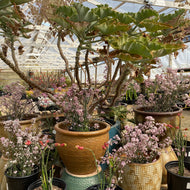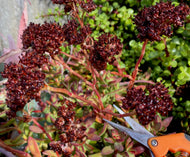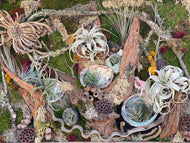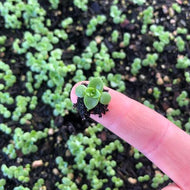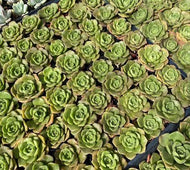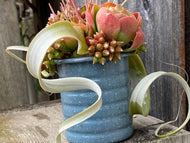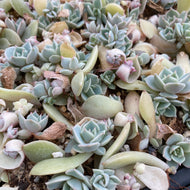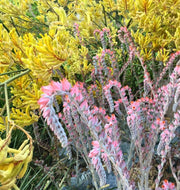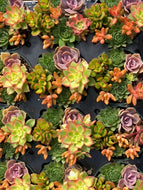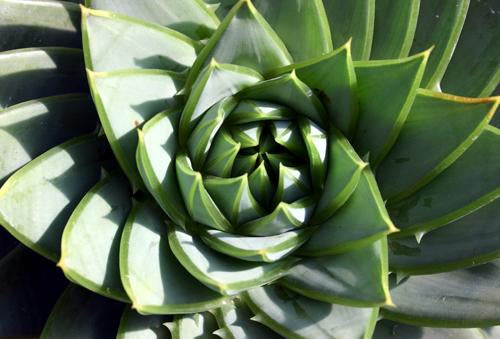
Summer has arrived! Right after Sunset Celebration, I took a short trip to San Jose del Cabo, at a surf break called the Rock. We arrived on a Sunday afternoon and were in the water at 5pm. My first wave of the trip was a disaster when someone lost his board as I was riding by. Three stitches in my shin, two days out of the water and I was good to go. The plants were hanging out back home, as only succulents can do, and didn't suffer in the least while I was away!
So here's what's going on with succulents this time of year:

Aeoniums are beginning to go to sleep for the summer, particularly in the warmer areas like the central valley, Sacramento and the deeper coastal valleys like Carmel Valley. Don't be surprised if some of your Aeonium's begin to defoliate as summer progresses. This is not a very good time to be pruning Aeoniums.
Echeverias have already begun blooming and more will follow. Watch for aphids on the flower buds. If you see the bugs, wash them off, or use bug spray. If you use bug spray on the Echeveria and some of the chemical collects in the center of the rosette, be sure to go back and rinse the chemical out to avoid chemical burn. Some people just prune the flowers to get rid of persistent bugs. This is growing time for Echeverias and a good time to do any pruning you might want to do. We will remove the flowers from the Echeveria elegans in a week or so, so the texture of the rosettes in our display beds will be more visible.
When plants are actively growing, it is also a good time to fertilize. I do not recommend any specific fertilizer. I do suggest reducing the dosage recommendation by 1/2 and only fertilizing about once each month. For mixed container plantings that are fully developed, you can reduce the dose by 1/2 again, just providing a maintenance feeding and trying not to encourage too much growth.
Agaves typically grow pretty well in the summer. Growth rates are noticeably increased by regular watering and feeding. Agaves can survive pretty well without water and feeding once they are established, but their growth will slow considerably and they may also get burned leaf tips. This is a good time to prune the lower leaves of the Agaves that you want to clean up. Plants that were damaged by hail this past winter can have their lower leaves removed now. Remember to protect your skin from the Agave juice which can be a bit caustic. Using a serrated blade, or sharp pruning saw usually works better than clippers to cut the fibrous leaves
Crassulas and Cotyledons are mostly growing in the summer and are also good candidates at this time of year for feeding, watering, pruning, and propagation.
Many of the Aloes are finished blooming and some may have big flower stalks loaded with seeds after the hummingbirds have been out there pollinating. Collect some seed and try growing some. If the flower stalks are completely dry, you can hold the stalk and rock it back and forth to remove it from between the leaves. You can also wait for this to occur naturally if you don't want to bother.
Sempervivums put out many of their offsets in the early to late spring. The offset will continue to grow larger as the year progresses. If the Sempervivum are in hot sun, they will tend to shrivel and the rosettes will often close up until the fall weather cools. I propagate the sempervivum rosettes year around, but take care in the hotter months to shade them for root growth.
Snails and Earwigs are active pests for the next several months. As for the Earwigs, hunt them down and get rid of them. As for the snails, there are some pretty good recipes and summer is a perfect time for a crisp white wine, Sauvignon Blanc, and Escargot. (Here's a recipe we found!)
A number of the Sedum will be blooming now. they are a bit like vegetables that bolt. Many seem to exhaust themselves by shooting up heavy blooms and they become quite spindly. After they finish blooming, pruning to encourage lower branching can be helpful. some varieties will wait until fall to grow back out. They sure are pretty now:




Many of the succulents will be easier to keep looking lush if they are protected from the hot summer sun, particularly if they are in containers. Placing containers in the afternoon shade by moving them under eaves, or a tree that's not too messy, can be a good way to do this. A well-placed patio umbrella also works. Hope you are all enjoying a fine summer!



